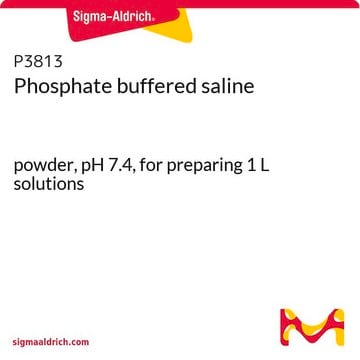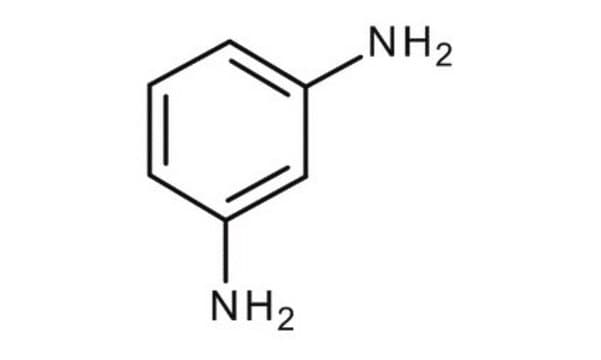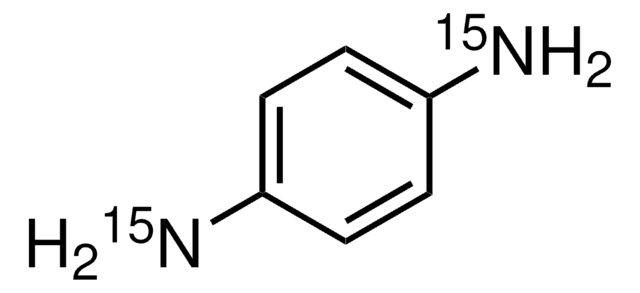We have no information on using this product for oxidase test. Product No. T3134, N,N,N′,N′-Tetramethyl-p-phenylenediamine dihydrochloride is commonly used to perform the oxidase test for the colorimetric identification of pathogenic and non-pathogenic bacteria.
Kluczowe dokumenty
P6001
p-Phenylenediamine
98% (GC)
Synonim(y):
1,4-Benzenediamine, 1,4-Diaminobenzene, 1,4-Phenylenediamine
Wybierz wielkość
257,00 zł
Wybierz wielkość
About This Item
257,00 zł
Polecane produkty
gęstość pary
3.7 (vs air)
ciśnienie pary
1.08 mmHg ( 100 °C)
opis
anti-fade reagent
Próba
98% (GC)
bp
267 °C (lit.)
mp
138-143 °C (lit.)
ciąg SMILES
Nc1ccc(N)cc1
InChI
1S/C6H8N2/c7-5-1-2-6(8)4-3-5/h1-4H,7-8H2
Klucz InChI
CBCKQZAAMUWICA-UHFFFAOYSA-N
Szukasz podobnych produktów? Odwiedź Przewodnik dotyczący porównywania produktów
Powiązane kategorie
Zastosowanie
- to evaluate its sensitization potential in vitro in langerhans-like dendritic cells and autologous T cells[1]
- to treat the dorsal sides of the ears of mice, to study its systemic immunological effects[2]
- in glycerol to coverslip coronal sections in the attempt to count Aβ plaques[3]
Anti-fade reagent is added to the mounting medium in fluorescence microscopy to retard photobleaching of fluorescein and other fluorescent dyes.
Działania biochem./fizjol.
Przestroga
Hasło ostrzegawcze
Danger
Zwroty wskazujące rodzaj zagrożenia
Zwroty wskazujące środki ostrożności
Klasyfikacja zagrożeń
Acute Tox. 3 Dermal - Acute Tox. 3 Inhalation - Acute Tox. 3 Oral - Aquatic Acute 1 - Aquatic Chronic 1 - Eye Irrit. 2 - Skin Sens. 1 - STOT SE 1 Oral
Organy docelowe
Kidney,Heart,Musculo-skeletal system
Kod klasy składowania
6.1C - Combustible acute toxic Cat.3 / toxic compounds or compounds which causing chronic effects
Klasa zagrożenia wodnego (WGK)
WGK 3
Temperatura zapłonu (°F)
230.0 °F - closed cup
Temperatura zapłonu (°C)
110 °C - closed cup
Środki ochrony indywidualnej
Eyeshields, Faceshields, Gloves, type P2 (EN 143) respirator cartridges
Wybierz jedną z najnowszych wersji:
Masz już ten produkt?
Dokumenty związane z niedawno zakupionymi produktami zostały zamieszczone w Bibliotece dokumentów.
Klienci oglądali również te produkty
-
May I ask if I can use P- phenylenediamine for oxidase test
1 answer-
Helpful?
-
-
What is the solubility of p-Phenylediamine, Product P6001?
1 answer-
This product is soluble in ethanol at a concentration of 50 mg/mL, with heating. A clear red to brown solution is observed.
Helpful?
-
-
What is the Department of Transportation shipping information for this product?
1 answer-
Transportation information can be found in Section 14 of the product's (M)SDS.To access the shipping information for this material, use the link on the product detail page for the product.
Helpful?
-
-
For what applications is p-Phenylediamine, Product P6001, used?
1 answer-
This is an antifade reagent that is used as a fluorescent stabilizer. Do not confuse the p-phenylenediamine with o-phenylenediamine, which is used as a peroxidase substrate in ELISA procedures.
Helpful?
-
-
What is the working concentration for p-Phenylediamine, Product P6001, when used as an antifade agent?
1 answer-
J. Immunological Methods, 43, 349 (1981) describes a solution that will reduce the fading of fluorescent materials. The recipe for this solution is: "Add 10 mL of phosphate-buffered saline (0.01 M PO4, pH 7.4 in 0.15 M NaCl) containing 100 mg of p-phenylenediamine to 90 ml of glycerol. The final pH should be adjusted to approximately 8.0 with 0.5 M carbonate-bicarbonate buffer (pH 9.0)".
Helpful?
-
Active Filters
Nasz zespół naukowców ma doświadczenie we wszystkich obszarach badań, w tym w naukach przyrodniczych, materiałoznawstwie, syntezie chemicznej, chromatografii, analityce i wielu innych dziedzinach.
Skontaktuj się z zespołem ds. pomocy technicznej












